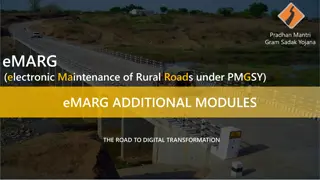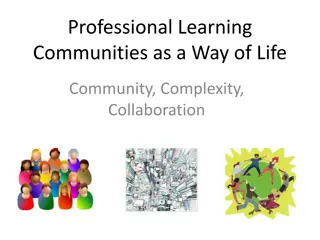The Impact of Roads on Communities: Connect or Divide?
Roads have significant economic and social impacts, connecting people to markets, education, and healthcare while also influencing spatial planning and community division. Case studies from Afghanistan, South Africa, and Palestine exemplify how roads can empower, segregate, or improve access based on their design and purpose. Challenges like road engineering standards affecting safety highlight the importance of balanced road development for inclusive communities.
Download Presentation

Please find below an Image/Link to download the presentation.
The content on the website is provided AS IS for your information and personal use only. It may not be sold, licensed, or shared on other websites without obtaining consent from the author.If you encounter any issues during the download, it is possible that the publisher has removed the file from their server.
You are allowed to download the files provided on this website for personal or commercial use, subject to the condition that they are used lawfully. All files are the property of their respective owners.
The content on the website is provided AS IS for your information and personal use only. It may not be sold, licensed, or shared on other websites without obtaining consent from the author.
E N D
Presentation Transcript
Do Roads Connect or Divide? The Other Side of the Road ......
Table of contents 1. The economic and social impact of roads 2. Meeting the need: roads in Afghanistan 3. Apartheid spatial planning using roads in South Africa 4. Use of roads to divide communities: West Bank, Palestine 5. Equity in road use 6. Road engineering standards and roads accidents 7. Gated communities 8. Conclusions
Economic and social impacts of roads Increased access to the market and town Increased production Empowerment Access to education, health, community Reduced transport costs
Connecting people in Afghanistan Outcomes of new roads following the war in Afghanistan: School attendance increased Access to clinics and hospital increased Travel times to clinic or hospital declined Access to the market improved
Apartheid Spartial Planning using roads in South Africa
Use of roads to divide communities in West Bank, Palestine
Road engineering standards and roads accidents Road and transport planning does not provide adequate integration between different road classes in new developments; Road guidelines do not reflect the special needs of some road users, such as older drivers, visually impaired pedestrians, children, elderly people, people with mobility limitations, and users of lower-speed alternative transportation devices; Roads standards do not adequately address trade-off between conflicting demands that are related to important road user characteristics; Roads specifications may not address specific combinations of roadway design features that can have an impact on road user behaviour and subsequent safety.
Roads planning and engineering standards This road in Mbombela remains very dangerous. There is now a wider sidewalk. However the through traffic travels too fast. No one abides by the speed limit. The type of development along the road does not support pedestrian-focused urban planning. The bus stops are not near an intersection and therefore people try to run across the road. Measures introduced do not make the environment
Wrong application: road widening This development is taking place on NMT routes to many schools, in a bus route and next to a park. Road widening at junctions makes the traffic speed up approaching the junction and makes it harder for pedestrians to cross This increases the likelihood of pedestrian accidents and means that vulnerable people are more at risk
How we plan cities: gated communities This developments are contrary to the cities Integrated Development Plans (IDP), and do not support Comprehensive Integrated Transport Plans (CITP) IDP and CITP promotes integrated development
Conclusion Department of Transport has given a lot of thought to new public transport systems Transit orientated development has been mooted as necessary around new public transport systems This can t work without a change in approach to the design of cities Regulations that support the implementation of universal design are now 11 years old. Why are they not being implemented? Roads standards in current use were developed in the 1960 s-1980 s how could it be that these do not support the continuation of the apartheid city? Roads standards at national level are voluntary. So why are these apartheid standards being enforced at provincial level without recognition Unless we think this through, we can t make the new transport systems work and we can t do ToD. The effect of roads standards in their current form makes it too expensive for government to implement its own policy Who is being hijacked?
Recommendations Recommendations While the old road standards are being reviewed and new one implemented much still need to be done in ensuring that this roads connect communities in instead of deadly traps Development should be holistic and prioritise the needs of all the road users Development of gated communities, malls, and RDP houses should be accompanied by safe pedestrian side walks, public transport facilities or terminals In order to reduce the accidents the road design should prioritise the needs of the vulnerable including the passengers with disabilities























